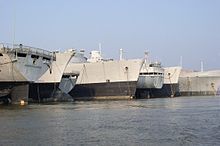Mulberry Island
This article needs additional citations for verification. (March 2009) |
Mulberry Island is located along the James River in the city of Newport News, Virginia, in southeastern Virginia at the confluence of the Warwick River on the Virginia Peninsula.
History
[edit]
Mulberry Island was home to Native Americans for thousands of years before the English came to settle it in the 1600s.[1] When Jamestown Island was established in 1607, many parts of the James River were mapped and patented. It was at Mulberry Island where the Jamestown colonists (fleeing Starving Time) were met by a June, 1610, supply mission of Thomas West, 3rd Baron De La Warr, which saved the English settlers.[2]
By 1614, thousands of acres were under cultivation with tobacco, the export crop introduced by John Rolfe which saved the Virginia Colony financially. In 1619, Mulberry Island was part of the plantation held by William Pierce, Rolfe's father-in-law.[3] By the end of the century, Edward Digges owned a plantation on the island, and attempted to cultivate silkworms on the native mulberry trees.
During the American Civil War, Mulberry Island was the southern end of the Warwick Line, a series of defensive works built across the Virginia Peninsula to Yorktown manned by troops of Confederate General John B. Magruder during the Peninsula Campaign of 1862.
From 1898 to 1918, Mulberry Island was home to Davis & Kimpton Brickyard.[4] The brickyard sat on the west bank of the Warwick River.[5]
Prior to its acquisition by the U.S. government for $538,000, Mulberry Island was primarily farmland. During the first World War, Camp Abraham Eustis was established on the historic island and adjacent land in Warwick County, upstream from Newport News Shipbuilding and Drydock Company. Named for Abraham Eustis, a famous U.S. Army General from Petersburg, the camp had balloon observation school, and an artillery school that remained in operation through the end of World War II. Camp Eustis became Fort Eustis and a permanent Army base in 1923. In 2010, it was combined with nearby Langley Air Force Base to form Joint Base Langley–Eustis.
Modern times
[edit]
Fort Eustis is currently home to the United States Army Training and Doctrine Command (TRADOC). Since 1958, following a political consolidation of the former Warwick County with the independent city of Newport News, almost all of the base and all of Mulberry Island are located within the corporate limits of Newport News. An Army Aviation School is also located at Fort Eustis.
An array of ships part of the National Defense Reserve Fleet are anchored adjacent to Mulberry Island in the middle of the James River. Considered an environmental hazard, the numbers of this reserve fleet are being reduced each year as ships are transported away as scrap. These ships are termed the "Idle Fleet" in local parlance.
References
[edit]Notes
[edit]- ^ "History of Fort Eustis". www.jble.af.mil.
- ^ Tyler, Lyon Gardiner. The Cradle of the Republic: Jamestown and James River. United States, Hermitage Press, Incorporated, 1906.
- ^ Piner, Huston (2020). The Riddles of Mulberry Island. NineStar Press. pp. 43–51. ISBN 978-1648900334.
- ^ Newport News Historic Sites[permanent dead link]
- ^ Opperman, Antony F.; Ralph, MaryAnna (1988). "Davis and Kimpton Brickyard" (PDF). Historic American Engineering Record. Washington, D.C.: Library of Congress. p. 1. Retrieved November 27, 2017.
Sources
[edit]External links
[edit]- Joint Base Langley-Eustis
- Fort Eustis official website (archived)
- Davis & Kimpton Brickyard - DoI National Historic Places Registration
- Historic American Engineering Record (HAER) No. VA-43, "Davis & Kimpton Brickyard", 12 photos, 5 measured drawings, 9 data pages, 2 photo caption pages
